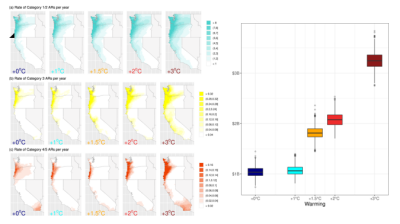Implications of Warming on Western United States Landfalling Atmospheric Rivers and Their Flood Damages
Atmospheric rivers (ARs) are critical to the western US water cycle. Based on their landfalling characteristics they can either be beneficial or detrimental to water managers. We investigate shifts in AR characteristics along different stabilized global warming scenarios. We combine a newly developed AR detection workflow (TempestExtremes) with 0.25° Community Earth System Model simulations designed to simulate a world that might have been (+0◦C), a world that corresponds to present-day warming (+0.85◦C), and several future worlds (+1.5◦C, +2◦C and +3◦C).
We provide a first-of-its-kind evaluation of how landfalling ARs may respond to several stabilized warming scenarios, namely shifts in their characteristics along different global warming trajectories and highlight the pragmatic implications of climate mitigation aimed at keeping global warming under +2◦C.
We show that global warming increases the number of water management relevant landfalling ARs from 19.1 ARs per year (+0◦C) to 23.6 ARs per year (+3◦C) along the coastal western US. Importantly, warming increases the fraction of ARs that are “mostly or primarily hazardous” to water resource management with 2% of ARs at +0◦C to 8% at +3◦C. This subtle-but-important shift in AR character has important ramifications on flood damages, whereby for every +1◦C of additional warming from present conditions we found that annual average flood damages increase by ~$1 billion (~$1.04 billion/year at +0◦C to ~$3.25 billion at +3◦C). Notably, there is still ample time to limit global warming to below +3◦C. Yet, even an increase of +0.5◦C from present day is projected to increase coastal western US flood damages by +$750 million/year (+70% from 2006-2015 rates).

